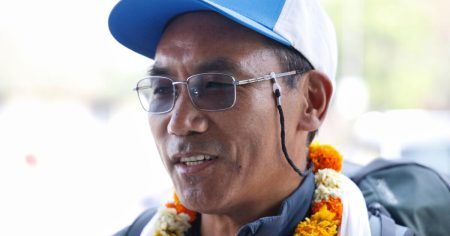Pope Francis was hospitalized on Friday after a persistent bout of bronchitis worsened, prompting the Vatican to announce that he would be undergoing treatment and canceling his public agenda through at least Monday. The 88-year-old pontiff, who has a history of respiratory health issues, was admitted to Rome’s Agostino Gemelli Polyclinic, where he has been treated for various health concerns in the past. The Vatican stated that preliminary tests indicated a respiratory tract infection, mild fever, and that Francis was in “fair” condition while receiving drug therapy. Despite his health struggles, Francis had continued to carry out his duties, albeit with visible difficulty, presiding over an outdoor Mass on Sunday and attending his general audience on Wednesday. However, his condition deteriorated, and he appeared bloated and pale during a handful of private audiences on Friday before being hospitalized. The bloating was likely a side effect of the medication he was taking to address the lung infection, which can cause water retention.
Francis’s health challenges are not new. He has long battled bronchitis, particularly during the winter months, and has undergone several medical procedures over the years. Notably, he had part of one lung removed in his youth due to a severe infection, which has left him with chronic respiratory issues. The pope has also become increasingly reliant on assistive devices such as wheelchairs, walkers, or canes to move around, and he has experienced recent falls that left him injured. Despite these physical limitations, Francis has maintained a busy schedule, though his breathing difficulties have become more apparent. During recent appearances, he has struggled to speak for extended periods and has relied on aides to deliver his speeches. Christopher Lamb, CNN’s Vatican correspondent, observed Francis during an audience on Friday and noted that while the pope appeared mentally alert, his breathing difficulties were evident.
The Vatican’s decision to hospitalize Francis came after a week of worsening symptoms. He was diagnosed with bronchitis on February 6 but continued to fulfill his papal duties, including meetings with Vatican officials and external visitors. On Friday morning, he met with Slovak Prime Minister Robert Fico before being admitted to the hospital. The Vatican emphasized that the hospitalization was necessary for further diagnostic tests and to continue treating the bronchitis in a controlled medical environment. While the exact duration of Francis’s stay was not disclosed, the Vatican confirmed that he would not participate in Holy Year events through Monday, including a planned audience with artists, a Mass, and a visit to Rome’s Cinecitta studios. A Vatican cardinal will preside over the Mass in his place, but other events were canceled due to his inability to attend.
Francis’s latest hospitalization has drawn attention to his broader health history. In June 2023, he underwent surgery at Gemelli to remove intestinal scar tissue and repair a hernia in his abdominal wall. Earlier that year, he spent three days in the same hospital receiving intravenous antibiotics for a respiratory infection. In March 2023, he revealed that he had been rushed to the hospital with a high fever and sharp chest pain, diagnosed as severe pneumonia in the lower part of his lungs. Francis has credited the quick action of medical staff and his personal nurse with saving his life during that ordeal. He was released from the hospital in April 2023, humorously remarking, “Thank God I can tell the story,” and expressing gratitude for his body’s positive response to treatment.
The Vatican’s communication about Francis’s health has evolved over time. In 2023, initial announcements about his hospitalization were vague, leading to confusion when Francis later revealed the severity of his condition. This time, the Vatican provided clearer information ahead of his hospitalization, likely aiming to avoid similar misunderstandings. Francis’s openness about his health struggles, including in his recent autobiographies Hope and Life, has also shed light on his experiences. He has spoken movingly about his near-death encounter with a lung infection in his youth, crediting an Italian nun, Sister Cornelia Caraglio, with saving his life by advocating for urgent medical intervention.
As news of Francis’s hospitalization spread, well-wishers gathered near Gemelli hospital, leaving votive candles and expressing prayers for his recovery. Nino Davi, a patient at the hospital, summed up the sentiment of many when he said, “I wish with all my heart that he will get better because these awful illnesses, you don’t wish them on anyone. So I wish with all my heart that he gets better.” Francis’s resilience and continued commitment to his duties have inspired admiration, even as concerns about his health persist. His ability to connect with people, despite physical challenges, underscores the deep affection and respect he commands globally. While his hospitalization is a reminder of his mortality, it also highlights his enduring strength and the significance of his role as a spiritual leader.









